A Quadriceps muscle strain is a tear of one of the four thigh muscles in the front of the thigh. Also referred to as a Quad strain. Your Quad muscles allow you to jump, walk, land and climb stairs. These muscles are mainly responsible to extend your knee and tilt your pelvis forward. A torn Quad muscle is not a walk in the park.
“Quad” means four, so we have the Vastus Medialis muscle on the inside, Vastus Lateralis muscle on the outside, and Vastus Intermedius & Rectus Femoris overlapping each other in the middle. All four these muscles originate from the pelvis and runs down the femur (thigh bone), they attach to top part of the patella to form the supra-patella tendon and infra-patella tendon. These tendons anchor the quads onto the top part of the shin bone called the Tibia.
What does your quadriceps muscle do?
The quadriceps muscle covers the whole front of your thigh and mainly controls your knee motions while keeping your kneecap stable. Everyone has felt tight sore thigh muscles after climbing a few flights of stairs, but a small taste of actual muscle trauma and more serious tissue damage.
Your Quadriceps muscle straitens your knee, flexes your hip, and tilts your pelvis forward. To understand how your thigh muscle gets injured you must first know how it works. Let’s look at these three movements. When you are standing and can activate your quads by just straightening your knee. Then lift your knee to your chest while your knee is bent, and you’ll notice that your quads muscle tilts your pelvis forward.
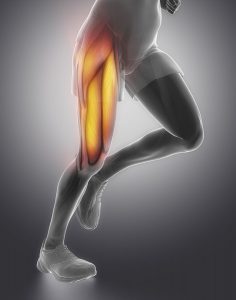
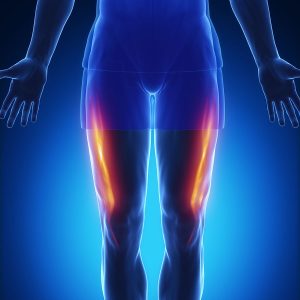
How does a Quadriceps muscle tear?
Under tension & stretch
Your quadriceps muscles are capable of generating large amounts of force to propel us forward and control our landing. As the muscle fibers contract the tension runs along the vertical lines of each of the muscles. The small muscle fibers tear when the force of contraction is overloaded, or too much power exerted. Even more so, when the muscle is in its stretched position. We go into this stretched position every time we give a stride when we run, jump, hop, and kick.
A muscle is put at a disadvantage when it’s put in a fully lengthened position and forced to contract out of a stretched position. Repeated over and over like sprinting downhill, creates microtears that join up, and eventually the muscle fatigues while still being overloaded leading to failure of the structural integrity of your thigh muscle fibers, shearing them one by one.
Small tears rip the quad into pieces
Repetitive overload on the thigh muscle causes small tears in the quadriceps muscle. Your body automatically activates a protective guarding reflex by contracting your quad to protect it from further strain, but people tend to train through this ‘niggle’ of pain and continue to run, cycle, jump, etc. It tightens up the muscle, and stiffness is more noticeable. This is compounded when you’re pushing the boundaries of distance and pace. This adds a fatigue component to the problem.
Initially, a small rattling sound in the car at 60km/h starts becoming deafening at 120km/h 2 hours on the highway. Eventually, a small quad tear develops into a bigger tear, until it is too painful to contract or stretch the quads at all. The torn quad fibers split apart usually accompanied by tears in some of the blood vessels inside the muscle. This bleeding inside the confined space of the muscle compartment is quite painful and stiff when you try to move.
A Quadriceps strain develops where the forces are concentrated over a specific area of the muscle. The most common site for this type of tear to develop is where the tendon meets the muscle (Musclotendinous junction). In most of these cases, there is a quadriceps tendinitis that can make matters even worse.

Causes of a torn Quadriceps muscle
The thigh muscle mostly involved in a Quadriceps strain is the Rectus femoris muscle which occurs during sports that involve sprinting, jumping, or a kick. In extreme cases the excessive force overload that these movements place on the muscle cause it to rupture, tearing along the muscle fibers or rupturing the membrane that contains your thigh muscles. In contact sports where a direct blow to your thigh bursts the muscle compartment causing excessive bleeding and making matters even worse.
Here are the factors that add to the risk of rupturing your Quadriceps muscles:
- Overload: Demand placed on your thigh to execute a task.
- Stretch: Length allows for ease of motion and using the muscle’s lever system to your full advantage without a lot of effort.
- Repetitive motion: Repetition strengthens, but also physiologically shortens the tight muscle.
- Fatigue: Pushing the boundaries of its capacity concentrates forces.
- Sudden deceleration of the leg (e.g. kicking)
- Violent contraction of the quadriceps (sprinting)
- Rapid deceleration of an overstretched muscle (by a quick change of direction).
When the right combinations of these are combined, you’ll risk tearing your quad muscle to some degree. The most common quadriceps muscle that gets strained is the Rectus Femoris muscle because it crosses two joints and has a high proportion of type 2 fibers.
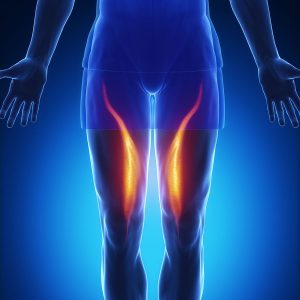
A recipe for a Quadriceps muscle tear is a quick stretch, at the same time as a forceful contraction
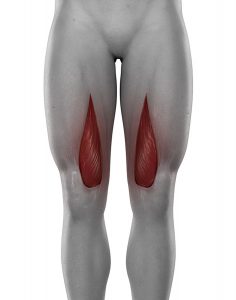
Vastus Medialis Muscle
The vastus medialis muscle is in the front of your thigh towards the inside. It straightens your knee and stabilizes the patella (kneecap), playing a vital role in controlling where the patella should move during movement (patella tracking). The lower portion of the muscle fibers of vastus medialis runs diagonally towards the patella which plays a very important role in locking the knee in full extension.
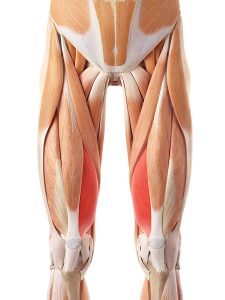

Vastus Lateralis Muscle
The Vastus lateralis muscle runs on the front and outside of your thigh. It straightens your knee and provides stability to the outer part of the upper leg, hip, and pelvis to stabilize sideways motions. Often overloaded in runners with poor hip stability.
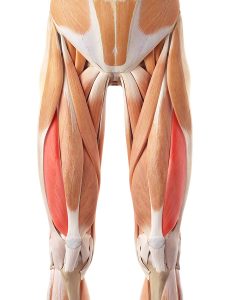
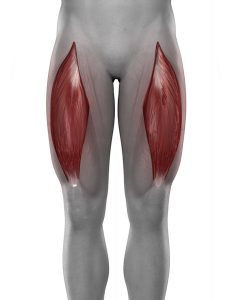
Rectus Femoris Muscle
The rectus femoris muscle is the only muscle that directly attaches to your pelvis. It lies on top of vastus intermedius and between vastus medialis and vastus lateralis. It raises your knee towards your chest and helps to extend your knee. It is also able to tilt your pelvis forward. It is the only one of the four quadriceps that runs over two joints.
With a Torn Quad muscle, specifically the Rectus femoris muscle, you’ll find it very difficult to stand up straight. Hip, pelvic, and knee movement will be stiff & painful. Therefore take extra caution if you suspect your this particular thigh muscle is torn.
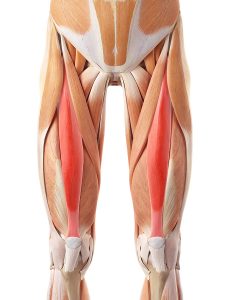
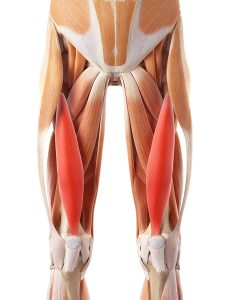
Vastus Intermedius Muscle
The vastus intermedius runs directly underneath the rectus femoris muscle in the front of your thigh. It helps straighten your knee and contracts in unison with the rectus femoris muscle but remains a separate group of muscle fibers to increase the force, power, and speed of knee motion.

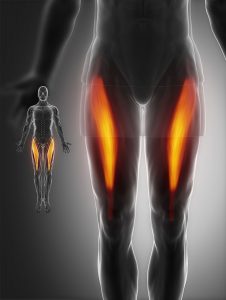
How severe is my Quadriceps muscle tear
Degree of Quad Muscle Tear
We use a scale from 1 to 3 to determine how bad the Quadriceps muscle strain is. This gives us a clear picture of how severe the tear in the quads is. We’ll tell you where, and to what extent the muscle is torn. The following sign classifies the priority and different degrees of quadriceps muscle strains. (For a more detailed analysis click here)
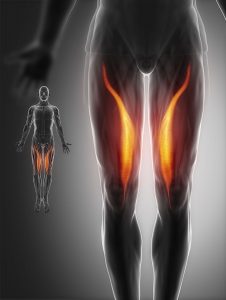
Grade 1
When less than 20% of the muscle fibers are torn the injury can be referred to as a strained quadriceps muscle. You’ll feel some discomfort and pain, but stiffness is more prominent. You will be able to put your weight on the leg, but you will experience some pain when walking. This means you’ll have no loss of function of the quad. Moving you quad to straighten your knee and flexing your hip is sensitive. The pain in our quad won’t stop you from carrying on to run, and finish the game. Beware that the stiffness will set in right after you’ve cooled down.
A small strain on a muscle should heal within a week without medical treatment. If the pain hasn’t subsided in 7 days, give us a call so we can have a look at it.
Recovery Time is 2 to 4 weeks if you follow the treatment advice & instructions we give you. We try to get you pain-free within 2 weeks, but we need to fix why your quads take so much strain. This is to prevent it from happening again.
Grade 2
20% to 80% of the fibers are torn.
Mild bruising over the quads that range from Yellow, Light blue to black. You will not be able to put weight on the leg, and if you brave it, you’ll feel a sharp sting in your quads. Even if you try to continue playing, you will have considerable amount of pain, while hobbling along as you limp. Most pain only comes on after you have ‘cooled down’, and stiffness sets in. The quad pain will not allow you to straighten your knee or lift your leg forward (knee to chest).
On the day it might not feel ‘too bad’, but the torn quad is excruciating the next morning. Activities like climbing stairs, bending to pick up something off the floor, putting shoes on and getting up out of the car or a chair will be quite painful over the quadriceps muscle. Thigh pain going down stair will be worse than going up.
Contact us immediately because you need medical treatment. The faster we have a look at it before the swelling and bleeding gets too much. We must determine where the tear is and identify which of the four quadriceps muscle are torn.
The time it will take to recover enough to be able to run, is 6 to 8 weeks. With early treatment we get you to start jogging in the 4th week.
Grade 3
Complete tear the fibers are torn & split apart
With complete separation of the tendon that anchors the muscle
When you contract your quads when standing you will see the top part of the muscle moving upward, but the bottom part will rarely move. Even at the site of the tear you’ll be able to see a dip or step over your quads. You’ll struggle to hold your knee straight, or you’ll feel unstable when you try to walk on it. Your quads will feel weak, as if its not able to hold you. Bleeding and swelling will definitely be present.
The main concern with a Gr 3 quad tear, is that the muscle re-attaches to the correct area to make sure that the muscle can still work. A Sonar or Diagnostic Ultrasound will show the full extent of the quadriceps muscle tear.
Contact us immediately because you need medical treatment. The faster we have a look at it before the swelling and bleeding gets too much, we can determine where the tear is and how many of the quadriceps muscles are torn. Depending on the muscles affected, surgery will be required to attach the separate muscle pieces.Surgery is the best option to re-connect the separated segments of the torn quad. However this is very rare. Ever tried to sew up a streak and then pulls it apart – the sutures rips through the muscle. Orthopedic surgeons rather would rather leave the quads to re-attach itself.
Your Recovery Period depends on how it’s treated: Conservative or surgical option. Conservative may be more than 8 weeks with intensive rehab. If you’ve completely ruptured your quadriceps muscle, recovery from surgery may take 4 – 6 months.
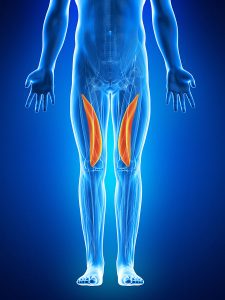
Contusions & Grade 2 quad tears
Ever walked into the side of a table, and gotten hit by a ball on your thigh? Leaving you with a massive bruise on your quad the size of a fist, or a line of bruising. This is called a contusion. This is due to the direct impact on the quadriceps muscles. The same goes for blunt trauma like a shoulder-to-the-thigh tackle or a direct kick from an opponent. The muscle fibers split shredding the membrane called the epimysium together with blood vessels and nerves in the area. That’s why the bleeding is excessive and severe. A Gr 2 Quadriceps muscle tear is very closely related to contusions of the thigh. It’s important to identify the depth of the bruise and if it extends into the muscle belly. Because if it extends deep into the quad muscles, you may risk tearing it even more.
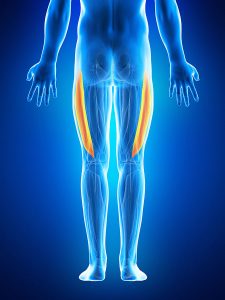
Diagnosis
Our physiotherapists can accurately diagnose the site & severity of a quadriceps muscle strain. In some cases, we refer for a sonar or diagnostic ultrasound to get a clear image of the torn quad muscle. This gives us valuable information regarding the length, depth, and total size of the tear. This provides us with more detail so we can more accurately define the prognosis (how long recovery will take) especially when you are pressed for time. By knowing the extent of the tissue damage we can guide you through a structured program to recover faster and safely return to the things you love doing. That’s why our physiotherapists are the best at diagnosing this type of problem.
We follow a structured plan to diagnose, classify the severity, and determine the hierarchy of priority that your thigh muscle needs. We stress, screen, and scan all the possibilities that could be causing your quadriceps muscle pain. We’ll identify any other injuries to surrounding structures. We understand the physiological healing stages you’ll go through, and custom-fit your treatment program.
X-rays
Muscles cannot be seen on an x-ray, so it will not be effective to diagnose a quadriceps muscle tear. X-rays will only be necessary if we suspect a fracture, however, this is very rare.
Your physiotherapist can refer you to get x-rays taken if necessary.
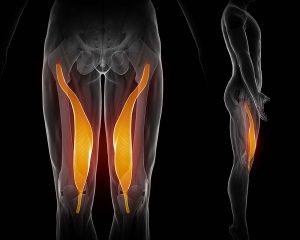
Sonar
Sonar or Diagnostic Ultrasound is very often used because it is relatively inexpensive. It’s important to establish the extent of the tissue damage, depth, width, and length of the tear, along with the involvement of the surrounding structures. We’re looking out for signs of bleeding, cracks in the cortex of the femur, and tendon attachments. Another advantage of Ultrasound is the fact that it can image the muscles ‘live’ and we can asses bleeding and hematoma formation via Doppler. We’ll ask you to contract and move your quads during the Sonar, and you’ll be able to see the torn fibers. But it also has a quite big disadvantage, namely the fact that it’s highly operator dependent and requires a skilled and experienced clinician. We have skilled professionals we’ll refer you to if needed.
MRI
Magnetic resonance imaging is a very expensive test. But in this scenario, it is a good way to give a detailed image of the torn quadriceps muscle. However, it’s very excessive if only the quad muscle is torn. If your physiotherapist suspects anything more than just a muscle spasm, you will be referred to the right specialist.
Why is the thigh pain not going away?
An untreated quad tear can lead to severe loss of mobility and flexibility in your hip and knee. Rarely, a contusion can lead to myositis ossificans, a painful condition involving muscle calcification. This is when bone crystals start to grow inside the quadriceps muscle. Stiffness becomes severe with a very limited range of motion.
If your thigh muscle injury is not healing as expected our physiotherapist may refer you for further investigations. If your quadriceps strain fails to respond to nonsurgical treatment your physiotherapist will discuss the options of draining the hematoma, or other treatment options.
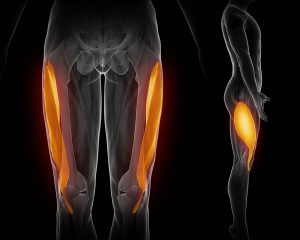
Problems we see when patients come to us with …
Several complications may arise if you do not get the correct management and treatment for a quad muscle strain. We prevent these complications from happening or getting worse. However – we can only do it if you see us before it’s too late.
Waiting too long
The longer you wait, the bigger your chances of causing more tissue damage. Before you run off to the ER, our practitioners can detect, prioritize, and establish the severity. It’s best to see it within 48 hours before the swelling and bleeding obscures accurate testing. The longer you wait, the more compensation kicks in. This brings up challenges in the treatment process that can be avoided.
Prolonged rest causes more damage than good.
During the first few days after the injury, a short period of immobilization accelerates the formation of granulation tissue at the injury site. Still, it is limited only until the scar reaches sufficient strength. This means that the scar can withstand the muscle-contraction-induced pulling forces without re-rupture.
Rest prevents the worsening of the initial injury. At this point, gradual mobilization is started, followed by a progressively intensified exercise program to optimize the healing by restoring the quad muscle strength, preventing muscle atrophy and extensibility, which can follow prolonged immobilization.
Using crutches too long
Wearing a thigh guard or brace has its benefits in the first phase of healing. Usually worn between 2 days to one week, a brace compresses your thigh and allows fibrous tissue formation to form while protecting it while recovering. But after three weeks, this is no longer necessary; we don’t want you to become dependent on it.
Starting strenuous activities too fast
It soon feels better with a bit of rest, but hold on before you lace up those tekkies. A common trend amongst patients is once they’re feeling a bit better, they just right back into it. Just like a wound that heals, the physiological healing process takes a while before the wound is closed up and hard enough to take strain. The biggest sign we see is people returning to training too fast after a quadriceps muscle tear, causing it to rip the tear open again. We’ll give you milestones that must be achieved to enable the muscle to adapt, overcome, and come back stronger. Our goal is to keep you as active as possible but safe.
Medication
Overusing pain medication to get you through the things you must do – is a short-term solution. You run the risk of more severe tissue damage, compensation, and abnormal tissue healing that can cause long-lasting effects. In some cases, it is irreversible. Medication is a pain management tool for the initial 2 weeks, allowing us to work on the site without discomfort.
Incorrect diagnoses and treatment
This article and all the information we provide are to give you a better idea of what the spectrum of the problem can be. However, making the wrong assumptions and doing more advanced exercises or stretches in the wrong healing phase can delay your recovery. There’s a lot of advice online on what to do, but they have no idea the extent of your tissue damage and severity, not to mention the subtle secondary complication you may have. Instead, know exactly what you’re dealing with before jumping into home remedies.
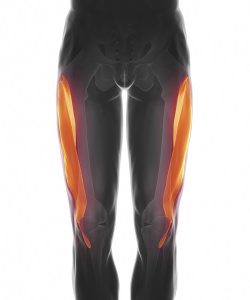
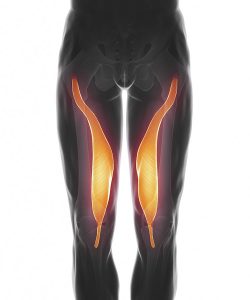
Physiotherapy treatment
A Quadriceps muscle tear can re-attach successfully if you guide and protect it throughout its healing phases.
Our Physiotherapists follow a 6 phase rehabilitation process where we guide you through each step.
If you are diagnosed with a Quadriceps strain your physio will advise you to continue with the PRICE protocol for up to 72 hours. We’ll advise you on some pain relief medications. You’ll have to use crutches for a few days, if you’re at high risk of tearing the muscle even further. Following the steps and guiding you as you progress safely from one phase to the next is the most important part of the rehabilitation process.
- Physiotherapy treatment focuses on pain management and accelerating the healing process by using Ultrasound and Laser
- Strapping and Taping to support and protect your quad from further injury by limiting knee flexion.
- Acupuncture or Dry Needling of the affected quadriceps muscles.
- Electrotherapy to desensitize the muscle’s protective mechanisms.
- Massage, Soft tissue mobilization and Myofascial release of Quadriceps muscles to guide the scar tissue formation.
- Dynamic, static and ballistic stretches
- Eccentric loading exercises to condition the quad muscle fibers.
- Compression braces like compression socks or neoprene sleeve can promote blood flow through the site of injury and prevent the blood pooling in the lower leg.
- Crutches for the first 2 weeks to keep your weight off the leg.
- We will gradually progress your rehabilitation exercises to regain full function and range of movement of all your quadriceps muscles.
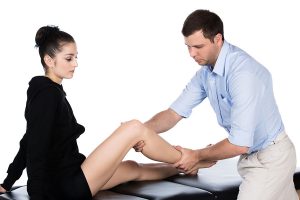
Phases of rehabilitation
1st Phase: Pain Phase (Week 0 – 1)
Ice or cold application is to lower intra-muscular temperature and decrease blood flow to the injured area. Compression may help decrease blood flow and is accompanied by elevation to decrease both blood flow and excess interstitial fluid accumulation. The goal is to prevent hematoma formation and interstitial edema, thus decreasing tissue ischemia. Limited Immobilization phase, is crucial for the quadriceps muscle regeneration.
When a quadriceps muscle strain occurs during a competition or training, it is important to react immediately. In the 10 minutes following the trauma, you must put the knee of the affected leg in at least 120° of flexion. This avoids potential muscle spasms and reduces the hemorrhage. If the knee is straight the scar tissue attaches in a shortened position and might struggle to regain its length later in the recovery phases.
2nd Phase: Eary Phase (Week 1 – 2)
By placing the injured leg to rest the first 3-7 days after the trauma, we can prevent further retraction of the ruptured quadriceps muscle (the formation of a large gap within the muscle), reduce the size of the hematoma, and subsequently, the size of the connective tissue scar. Elevation of an injured leg above the level of your heart results in a decrease in hydrostatic pressure, and subsequently, reduces the accumulation of interstitial fluid, so there is less swelling at the site of the tear.
To progress to the next stage you should be able to:
- Practicing squats. This should cause minimal pain.
- Deep-water running at 20 -30 minutes at high intensity intervals.
- Upper limb weight training (non weight bearing on the legs) – start from the first day after the injury.
- Cycling as pain allows.
- Isometric: Quad muscle contraction without change in muscle length (mostly against a fixed object).
- Isotonic: Quad muscle contraction against a constant resistance with a shortening/lengthening of the muscle.
- Isokinetic: Quad muscle contraction into a specific movement, through the available range (e.g. flexion-extension of the knee).
All of these exercises should be done in a range of motion that is pain-free.
3rd Phase: Intermediate stage (Week 4 -8)
You should now be able to go up & down stairs pain-free, and complete a single leg squat at 90 Degrees.
You may begin:
- Gentle stretches of your quadriceps muscles. Aim for symmetry in both legs.
- Functional warm-up drills such as walking lunges, full body exercises, low-level foot plyometrics, low levels sideways drills.
- Box step ups
- Interval cycling at a medium to high intensity
- Low level running
- This must be done in available pain free, and end of range as guided by your physiotherapist.
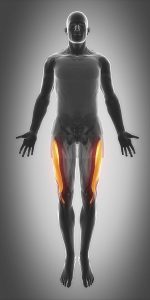
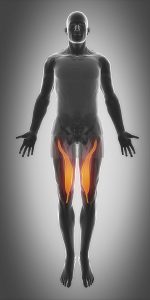
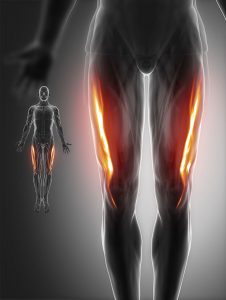
Healing time
Most quadriceps strains heal within 4 to 8 weeks. Return to sports participation will take longer and should not be confused with the healing period. This is guided by the medical professional treating you to ensure you’re safe to put the quadriceps muscle and surrounding structures under stress.
The amount of sessions required depends on the severity of the quad strain and your cooperation with the advice we give you. Every person is unique, so it varies. A general rule of thumb our Physiotherapist tend to stick to 2 treatments in the first two weeks, then only one treatment session for the next two weeks, increasing the interval length between each session as we progress until you’ve made a full recovery.
Other forms of treatment
- Your doctor (GP) provides pain medication for rehabilitation to start as soon as possible.
- Manipulations on your thigh, hip, or knee have shown to have little effect if any. It’s not recommended for a quadriceps muscle tear.
- A biokineticist will be able to help you in the final stages of your rehabilitation and get you back to training for your sport.
- Wearing a guard or brace protects your thigh muscle in the early phase, but must be limited to 2 weeks.
- Stretching or foam-rolling might ease your pain temporarily, but must not neglect the more important healing components that must first be fixed.
Is surgery an option?
Surgery is necessary when there’s complete separation of the anchor (tendon) away from the bone. Even complete ruptures are rarely operated on, due to the risk of the sutures tearing through the contractile tissue. Intra-muscular tears are a non-operative protocol that has proven to be very successful.
Surgery for torn quad muscles is very rare. After surgery, your doctor will put your leg in a cast or brace for 4 to 6 weeks, but you will need crutches for 6 to 8 weeks. Your doctor will refer you for a physiotherapy rehabilitation program to restore the normal quadriceps muscle strength and elasticity, so you can make a full recovery. All the components of the muscle must be restored before you consider going all out again, this includes, speed, power, stability, firing sequence, and extensibility.
What else could it be?
- Quadriceps tendinitis
- Tendinitis
- Knee Tendinitis
- Knee Meniscus Tear
- Contusions
- Runner or Jumper’s Knee
- Slipped Capital Femoral Epiphysis
- Hip pain
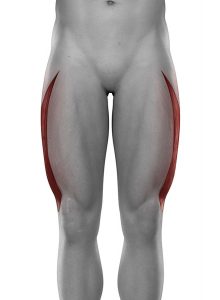
Also known as
Quadriceps tear, Torn Quads, Strained Quadriceps muscle, Torn Quadriceps muscle, Pulled Quads. Quadriceps muscle strain, Torn Rectus femoris, Torn Vastus lateralis , Torn Vastus Medialis, Torn Vastus intermedius.

